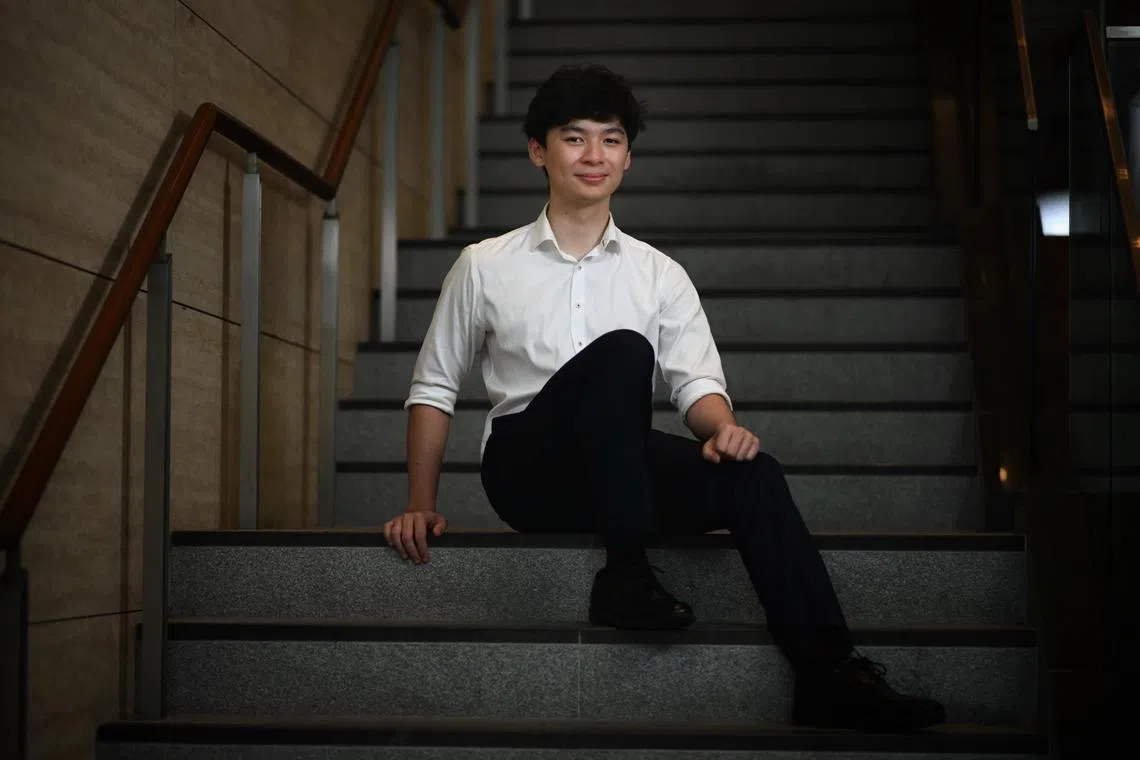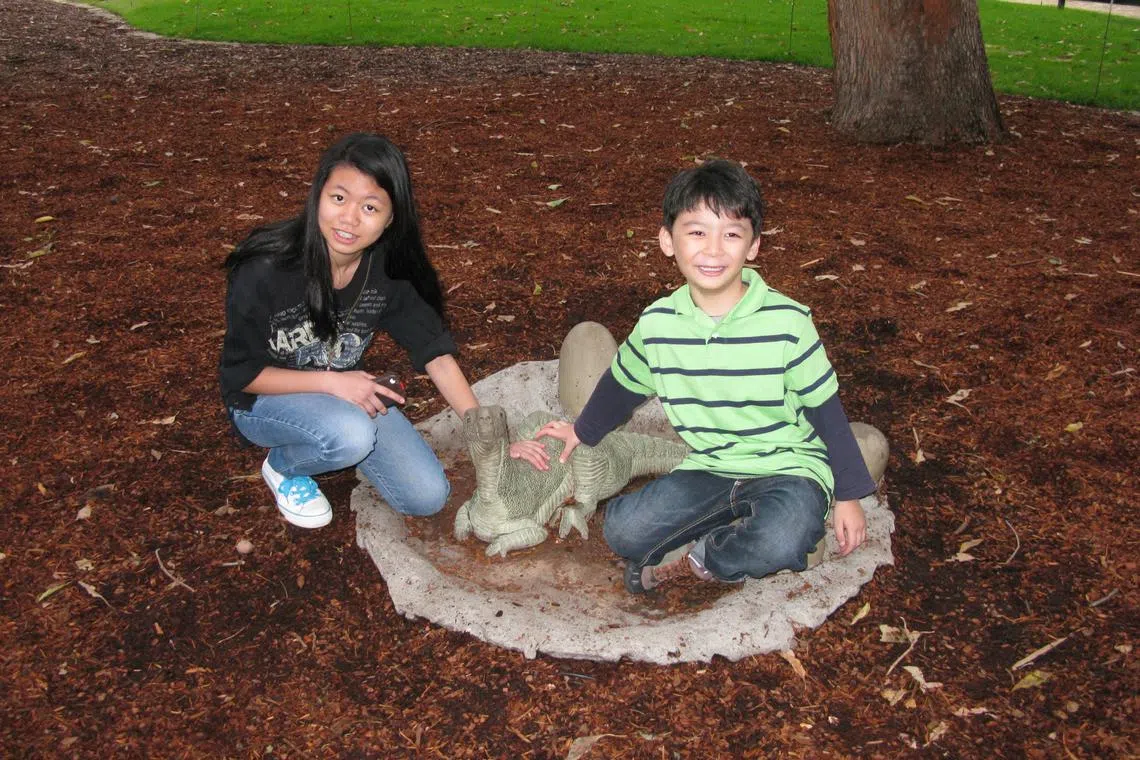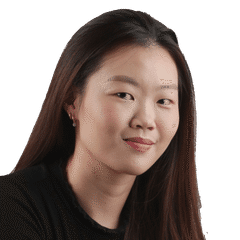Young S’porean gets thumbs up from Nobel Prize winners for science question, just like his sister
Sign up now: Get ST's newsletters delivered to your inbox

NUS medicine undergraduate Aedann See won the Molecular Frontiers Inquiry Prize in 2024.
ST PHOTO: CHONG JUN LIANG
Follow topic:
SINGAPORE – Can science help us replicate the unique mechanism some bats use to resist cancer?
This was essentially the question that won Mr Aedann See, 19, the Molecular Frontiers Inquiry Prize in 2024.
The competition – which takes place every two years – rewards young people for asking the best questions.
Mr See, now an NUS Yong Loo Lin School of Medicine undergraduate, submitted five questions after watching a South Korean film about a troubled teen finding new meaning in life after working at a hospice.
The film inspired the young Singaporean to volunteer at a hospice in 2024, where he met terminally ill seniors with cancer and lung diseases.
“During the process of caring for these patients, I started thinking how we can help to improve terminal care among them, and how future research can help to treat or prevent these diseases,” he told The Straits Times.
He discovered how certain bats with long lifespans resist cancer by producing high amounts of a protein that pumps DNA-damaging compounds out of their cells.
This led him to ask his winning question in the Molecular Frontiers Foundation (MFF) competition about whether humans could undergo evolution or genetic modification to develop a similar mechanism to protect them from cancer.
His other questions also revolved around the human body and health.

Mr Aedann See, 19, holds a photo of his sister Deanna, who won the award in 2017.
ST PHOTO: CHONG JUN LIANG
The competition is organised by the MFF, whose members are top scientists, including at least 14 Nobel Prize winners.
It awards 10 young people worldwide – five boys and five girls – for asking the best scientific questions. The only rule is that they have to be under the age of 18 at the time of submission.
Winners get a medal, a certificate and a gift.
While the prize – which used to be annual – is awarded only to 10 young people worldwide, Mr See is the second in the family to clinch it. His sister, Ms Deanna See, 25, won the award in 2017 for asking why it is harder to recall smell than other senses like hearing and sight. This inspired her brother to follow in her footsteps.
From flipping through encyclopaedias and science magazines to watching science TV series MythBusters, the siblings developed a fascination with science in their early years.
“Growing up, we were definitely kids who would not stop asking ‘why’,” said Ms See.
“We associated science with fun, and we learnt a lot from each other just from indulging in our curiosity, like figuring out if a bug that flew into our home was a moth or butterfly based on how it rested its wings.”

Ms Deanna See (left) and Mr Aedann See developed a fascination with science in their early years.
PHOTO: COURTESY OF AEDANN SEE
Their parents took them to various museums; one of them was the Live Turtle Museum, where the siblings had the chance to peek into the anatomy of various turtle and tortoise species.
Ms See developed an interest in biology in secondary school, and landed a mentorship at A*Star – as part of the research studies programme at school – with nanotechnology scientist Jackie Ying, who taught her how to ask good questions and think about solutions creatively.
At the tender age of 14, she was exposed to advanced lab equipment and techniques.
At A*Star, she said, she was shown how to conduct tests to examine how efficient different biomaterials were at preventing blood clots.
She also explored lower-cost alternatives for medical test strips, she added.
In 2016, when she was 17, the budding scientist netted a university scholarship from a foundation funded by Facebook founder Mark Zuckerberg.
She impressed with a five-minute video in which she explained antibiotic resistance using markers and Lego figurines, winning the Breakthrough Prize Foundation’s Junior Challenge competition.
The challenge required participants to explain a difficult concept in mathematics, life sciences or physics with an original video, and drew more than 6,000 entries from 146 countries.
The win brought her to Silicon Valley, where she mingled with tech titans, scientists and other Breakthrough laureates, and later became intrigued by how science, technology and people interact.
Her accomplishment inspired her brother to continue pursuing his interest in science.
“My sister inspired me to always ask questions. And that only when we ask enough ‘whys’ can we really stumble upon the answer to our questions,” he said.
Currently a first-year undergraduate student at the NUS Yong Loo Lin School of Medicine, he hopes to become a doctor as well as help advance medical research to improve patient outcomes.
“How the human body works together seamlessly is just really cool and fascinating to me,” he said.
His parents, who are not scientists, played a big role in fostering their children’s curiosity and supporting their interest in science. They subscribed to science magazines and took their children to museums and the Science Centre.
As a consequence, they also became more inquisitive and started talking science during meals.
“The conversations often evolve from something one of us read or something the kids have learnt in class, and it makes dinner time feel like a little family science session,” said Mr Clarence See, 61, who is a simulator flight instructor.
“Being in aviation, I like to talk to my kids about flying. As a family, we’ve had a lot of fun discussing things like how planes stay in the air or how weather patterns affect travel.”
On his love for science, the younger Mr See said: “Science is something that just never ends. In a way, scientific work is never finished. Every discovery we make just opens up another area of science that we haven’t really explored, and this leaves many questions for us to ask and answer.”
Currently, he is most interested in ophthalmology, or the study of medical conditions relating to the eye. He said he hopes to better understand the medical needs of less-privileged communities.
His sister became a technology consultant in 2023 after obtaining a bachelor’s degree in Cognitive Science and Media Studies from the University of Virginia in the US.
At school, she spent most of her time poring over the intersection of science and media.
“Through college, my interests shifted from ‘What makes us human?’ to ‘Can we stay human with technology?’” said Ms See.
Now, her favourite part of the job is experimenting with technology like generative AI tools and digital interfaces.
“While it sounds like a big leap from the life sciences, I think that this field may eventually encompass technology as well, given how much our behaviours are facilitated and altered by it today.
“In any case, I’ll continue to be a big fan of studying life, whatever form it takes, 10, 20, or 50 years down the line,” she said.


